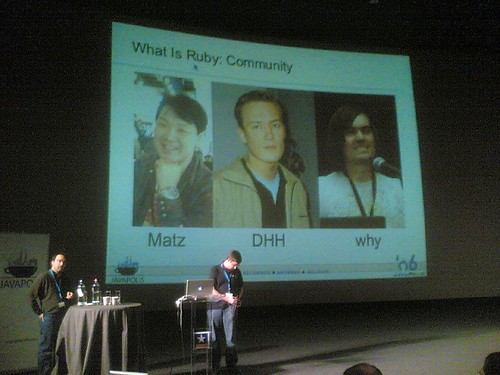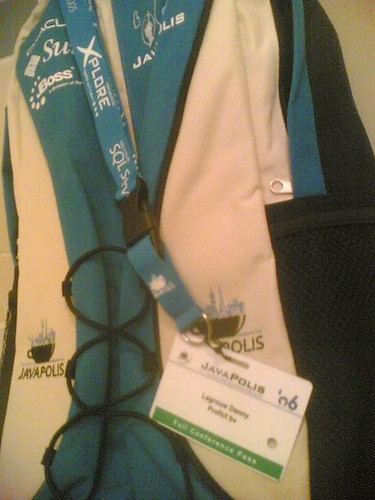So much to do in this hot and cold summer (July: 36 degrees, August: 16 degrees) and so little to blog about. In case anybody wonders, this is what I’ve been up to lately.
Gone back two years in time: After I finally left the WebLogic project in May, a little later than planned, I was re-assigned to the organization I worked at two years ago. It was as if time had stood still when I got back there. Not only because there were many familiar faces to welcome me, but also because the entire development environment was pretty much as I’d left it. So it’s back to Java 1.4, back to Struts, back to EJB’s, back to this pre-SOA SOA architecture… Then again, as someone asked me: what would I use instead of Struts? What indeed, if not Ruby and Rails? Does it really matter which XML-infested Java framework you use? Would Shale or Spring MVC make so much of a difference? I get by because there’s a lot of code and XML to copy/paste from, but the amount of code that is the result is frightening.
Trying to keep up with the insane tempo of the JRuby guys: After trying to get Rails on JRuby to work for my NLJUG presentation in May, with help from Charles Nutter and Tom Enebo, the JRuby protagonists, I kind of stuck around on the JRuby mailing list, which reads like a Dan Brown novel (well it does if you like coding). I even got a small job, rewriting Mongrel’s HTTP/1.1 Ragel parser to a JavaCC grammar (Why is there no Ragel-to-Java translator? I wish I’d had the time to write one. Now I had to use JavaCC, which was rather frustrating, either because of the limitations of JavaCC, especially in its idea of regular expressions, or because of my own limited knowledge of parsing–but it’s here, checked in in a fresh new RubyForge project, ) and it seems to be working. Mongrel will work completely with JRuby if Ola gets his JRuby extension framework going, allowing you to extend the Ruby language with Java libraries as easily as you can now with C libraries.
Organizing the Java Summer Camp 2006: After last year’s success with Simon Ritter‘s presentation of Java 5’s new features (fortunately no-one seems to remember the train mixup that got Simon 50km away from the venue and cause Rietje (office Mom) and me to pick him up there and drive back at questionable speed), Profict decided to do another Java Summer Camp this year. Like RubyEnRails before, this turns out to be very time-consuming. Finding a theme (Java & Ajax), speakers (Greg Murray! Bram Smeets!), visitors (90+, we’re fully booked!), a venue (another castle!), seats, food, sound system, camera, parking space…
Got my first production-worthy Rails application live: as a side note to the Java Summer Camp, I rewrote the small Rails app that I used to keep track of the RubyEnRails visitors. It can now handle multiple events, multiple users, it sends bulk email to visitors, it exports visitor data to Excel to keep the managers happy and it has a new and improved gui (which took me longer to design then it did to code the application itself).
Busy finding new colleagues: Yes I know, I should be proclaiming the wonders of Ruby and Rails at all times–but the truth is, I don’t hate Java, I don’t mind (that much) doing Java as a day job, and I don’t mind working for a Java shop. Although I’ll never quit dreaming of my own world empire, someday, somehow–in the meantime I’m very happy to be working for Profict. In spite of its focus on doing application integration projects (some people love diving in at the deep end, writing code that never sees the light of day; but I prefer staying near the surface, where the code reaches the user’s screens); but there’s enough work to do at the edges of integration: portals for one; and there are always the external assignments that I’ve been on for the last couple of years (what’s English for detacheren??). But what I really like about Profict is the fact that it’s small enough to know everybody (no huge consulting firm for me, thank you). It is a close group of mostly very experienced people, formed over the years only ‘by invitation’ (employers asking those people around them to join that they themselves would like to have as colleagues). So maybe I shouldn’t advertise the fact that we’re looking for still more people on my blog, for everyone to read–on the other hand, if you’re persistent enough to read this blog entry, you’re welcome to come talk (well, if you live in Holland anyway)! Okay, end of shameless commercial intermezzo…
Done a Grey’s Anatomy and The O.C. marathon: If you hate The O.C., you have got to at least love its theme song: California by Phantom Planet. That alone makes me want to go there (or at least as soon as flying to the US becomes a little more relaxed again). And Grey’s, what can I say: it’s little more than the 835th romance-in-a-hospital show (St. Elsewhere, Chicago Hope, ER, Medisch Centrum West) but there’s something that makes me want to keep watching–maybe Izzie? (A supporting character is usually my favorite: Summer in The O.C., Chloe in 24, Paris in Gilmore Girls, Starbuck in Battlestar and of course Locke in Lost; the exception is Prison Break).
Making the switch to Linux: Somewhere in the process of getting Subversion with SSH to work under Windows XP, which proved a hopeless case, either with or without Cygwin or VMWare, I decided to to finally make the switch. I shrinked my XP partition (I’ll still need it for graphics and photography work, as I just can’t get the Gimp to do what I want just as easily) and installed Ubuntu Dapper Drake. It feels like coming home (I worked with VMS and Unix long ago). It’s still not MacOS yet, but at least my 3GHz Dual Core cost just a third of Apple’s new beast…

